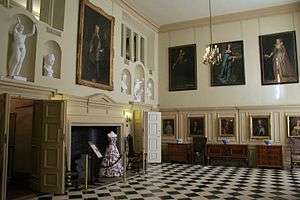Christchurch Mansion



Christchurch Mansion is a substantial Tudor brick mansion house within Christchurch Park on the edge of the town centre of Ipswich, Suffolk, England. It is now owned by the town and since 1895 has formed one of the two principal venues of the Ipswich Corporation Museums, now part of the Colchester and Ipswich Museum Service.
The Grade I listed building mansion houses a collection of pottery and glass, a contemporary art gallery and a collection of paintings by artists including John Constable and Thomas Gainsborough. There are rooms preserved as past inhabitants would have known them, complete with original items of fine clothing.[1] The house sits within a 70 acres (28 ha) public park which features many beautiful trees, rolling lawns and ponds.
History of Christchurch Mansion

Christchurch Park was originally the grounds of the Priory of the Holy Trinity, with an area of many square miles, coming up to the medieval town walls. During Henry VIIIs dissolution of the monasteries, the monastery was dissolved and the land was purchased by Sir Edmund Withipoll, who built the mansion in 1548-50, the ground floor of which remains largely as he left it. His granddaughter, Elizabeth Withipoll, married Leicester Devereux, 6th Viscount Hereford and the mansion passed to the Devereux family, who rebuilt the upper floors after a fire in about 1670, when the main porch was also added.[2] In 1734, Claude Fonnereau purchased the mansion from Price Devereux, 10th Viscount Hereford. A road next to the park is named after the family.
In 1894 the mansion was bought by Felix Cobbold, from a syndicate of property developments, save the building from demolition. Cobbold, a wealthy local businessman and philanthropist, then offered to give it to the Ipswich Corporation to establish a Museum and Art Gallery, together with a further £20,000 (equivalent to £2,050,000 in 2015)[3]in Ipswich Stock for the purchase of artworks.[4] His offer was on condition that the corporation buy the surrounding parkland for the people of Ipswich. It took Cobbold three attempts to get the corporation to agree to this, but in February 1895 the mansion was transferred to the town and in April 1895 the corporation purchased the central part of the park. The corporation acquired the upper arboretum in 1928.[5] Felix Cobbold, among other members of the wealthy Cobbold family, have donated a great deal of land to the people of Ipswich, including Ipswich Racecourse.
Notable works
Notes
- ↑ Historic England. "Details from image database (275383)". Images of England.
- ↑ Norwich, 595
- ↑ UK CPI inflation numbers based on data available from Gregory Clark (2016), "The Annual RPI and Average Earnings for Britain, 1209 to Present (New Series)" MeasuringWorth.
- ↑ "Felix Thornley Cobbold MP JP". Felix Cobbold Trust. Retrieved 23 January 2010.
- ↑ "Christchurch Park - A Chronological History". Ipswich Borough Council. Retrieved 23 January 2010.
References
- Ipswich Borough Council. (1989) Christchurch Mansion and Park Ipswich: An Illustrated Souvenir. Ipswich: Ipswich Borough Council. ISBN 0-906688-09-4
- Norwich, John Julius. (1985) The Architecture of Southern England. London: Macmillan. ISBN 0-333-22037-4
External links
| Wikimedia Commons has media related to Christchurch Mansion. |
- Christchurch Mansion Official website
- Christchurch Park history at Ipswich Council
- Friends of the Ipswich Museums
- Chrastchurch Mansion at britainexpress.com
- Map sources for Christchurch Mansion
Coordinates: 52°03′38″N 1°09′30″E / 52.0606°N 1.1582°E